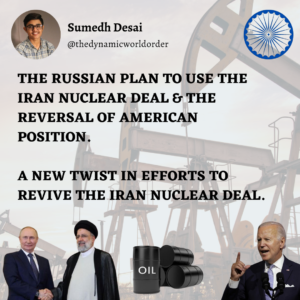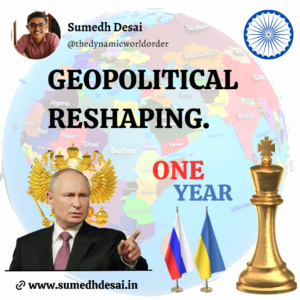The strategic community in India has been focused on debates revolving around BRICS expansion this entire week. While Prime Minister Modi was on his visit to Johannesburg, where the 15th BRICS Summit was held, two different schools of thoughts were engaged in deciphering the pros and cons of what India should do in the face of BRICS expansion.
The first school of thought revolved around the dangers that the expansion might bring, to the organisational structure as well as to the growing domination of India’s arch-competitor China, in the BRICS. The weight of intellectual opinion was way higher in this case as compared to the other opinion. The differing opinion resonated with the need of BRICS expansion in a world which is slowly yet constructively focused on reforming global governance in favour of creating a multipolar world order.
HISTORY OF BRICS
Back in the early 2000s, an economist from Goldman Sachs sought to engage the international investors into looking at four emerging economies to place their money in. These were Brazil, Russia, India and China, touted at the time as BRIC. The Russians had a Prime Minister named Yevgeny Primakov back in the day when President Boris Yeltsin was reshaping the policies of the Russian Federation. According to PM Primakov, it was in Russia’s national interests to forge a trilateral between Russia-India-China, often referred to as RIC.
Despite just being an acronym for the international investors, the idea to bring Russia, India and China on a common platform and enhance economic relations caught the fantasies of the Russian policymakers. They worked to build this group informally to begin with. Post the Global Financial Crisis of 2008, the Russians as did the Chinese, thought that the monumental point of Western hegemony over global financial architecture had witnessed the beginning of its end.
INCEPTION OF BRICS
Come 2009 and the Russians were at the forefront of getting BRIC institutionalised. In 2010, the group realised that it had members from Eurasia and Latin America but a representation from the African continent would further advance the objectives of the platform. Hence, South Africa was invited in 2010 as the first real expansion of BRIC into BRICS.
Since 2010, BRICS has worked in various domains including building alternative Multilateral Development Banks like the New Development Bank. It has also worked in building a BRICS Contingent Reserve Agreement (CRA) which provides protection to countries against liquidity pressure like the currency swap. BRICS is also considering building an alternative payment system to the western dominated SWIFT system.
The BRIC thesis holds that China and India will become the hub of the world’s manufactured goods and services, while Brazil and Russia will become leading suppliers of raw materials. At present, the BRICS accounts for more than 25% of the world’s land mass; more than 40% of world population; over 50% of world economic growth; and around 30% of the world economy.

PREPARING FOR A NEW WORLD
The real catalyst behind the idea of expanding BRICS to welcome over 40 interested countries phase-wise has been the Russo-Ukraine conflict. It has caused considerable pain to the Global South in terms of food, fertilisers and fuel crisis. The already impoverished countries were forced to take sides in order to get support at the international institutions. This is really what got them into this idea of joining BRICS to access the non-western developing world at equal terms.
As far as the 15th BRICS Summit is concerned, it was hosted by South Africa. South Africa has ratified the Rome Statute which makes them a member of the International Criminal Court. The ICC has issued an arrest warrant against the Russian President Vladmir Putin over the conflict in Ukraine. By mutual consensus, the Russians and the South Africans decided that President Putin will not travel to South Africa to avoid any further legal complications for the host South Africa. However, he was represented by his Foreign Minister Sergei Lavrov, who stood with the stalwarts in Brazilian President Lula Da Silva, South African President Ramaphosa, Indian Prime Minister Modi and the Chinese President Xi.

BRICS 2023 SUMMIT
In what was a smart move by the South African leadership, they invited the African countries to the Summit and named the theme as “BRICS and Africa: Partnership for Mutually Accelerated Growth, Sustainable Development and Inclusive Multilateralism”. At the Johannesburg Summit, the leaders issued the “Second Johannesburg Declaration”. It is a timely document emphasising on the need of the developing world to reform global institutions and the laws governing the international financial system.
There were references made to the conflicts in Niger, Libya, Yemen and Sudan. The declaration welcomed the two monumental events in West Asia – the reestablishment of diplomatic ties between the Kingdom of Saudi Arabia and the Islamic Republic of Iran as well as the reinduction of the Syrian Arab Republic in the Arab League this year following a decade long isolation. These events were not only welcomed by the leaders, but these events form the basis on why India was pragmatic in letting the BRICS expand.
BRICS Expansion
BRICS nations have been in consultation over expanding the group for a year. Reservations against the expansion were mainly from the Indian side and the Brazilian side, the fear being that the grouping might tilt towards authoritarianism if the expansion process is not duly agreed upon. President Ramaphosa declared at the end of the summit that the guiding principles, standards and procedures of BRICS expansion have been established and the consensus between the five nations have been reached on granting memberships to the Kingdom of Saudi Arabia, the Islamic Republic of Iran, United Arab Emirates, Arab Republic of Egypt, Federal Democratic Republic of Ethiopia and the Argentine Republic.

If one analysis the importance of Saudi Arabia, Iran, Egypt and UAE in all the conflicts going around in the Islamic world today, one can comprehend how important it was for the BRICS to include the key players of West Asia-North Africa (WANA) into the fold so that the attempts made by the Chinese to mediate between Saudi Arabia and Iran as well as the Russian mediation to get Syria back into the Arab League are fruitful with the inclusion of these four countries in BRICS.
India played it smartly because India is the closest to West Asia, far closer than Russia and China. For India, not being an irritant in the expansion process was looked at by the 40 interested countries as India’s true intentions behind championing the cause of the Global South. India understands that restoring the Balance of Power in West Asia needs a joint effort by Russia, China and India. Russia and China have played their roles and it was essentially in India’s strategic interests to not intervene in the process of reintegration of the region into BRICS.
However, concerns are that the Chinese will use BRICS to advance the BRI agenda. There are also concerns of Russia holding BRICS hostage to their Great Power Rivalry with the West. The Chinese and the Russians are as important for BRICS as Indians. India has to focus on negotiating an institutional regime for any further expansion that gives India an equal footing and denies China the opportunity to totally dominate BRICS with the power of its wallet. Sitting in the room and being a naysayer is detrimental to India’s growing aspirations of reframing the rules of global governance.
Visit us here.




